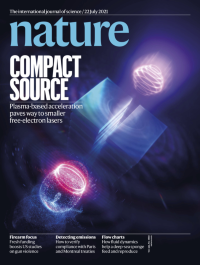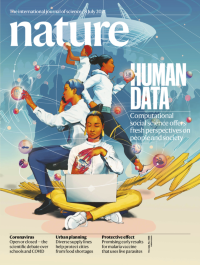Volume 595
-
No. 7869 29 July 2021
Two strikesHepatocellular carcinoma (HCC) is one of the most common forms of liver cancer — and is also aggressive and very hard to treat. Patients who have advanced HCC are currently given a targeted therapy such as lenvatinib, a multi-kinase inhibitor. But lenvatinib has so far had only limited clinical success. In this week’s issue, René Bernards and his colleagues present the results of a CRISPR–Cas9 genetic screen that reveal a potential role for epidermal growth factor receptor (EGFR) in limiting the effectiveness of lenvatinib. Working first with animal models and then with 12 patients who had advanced HCC, the researchers found that administering gefitinib, which inhibits EGFR signalling, alongside lenvatinib generates a positive increase in response to the drug (illustrated on the cover by the idea that only those tumour cells that receive two drugs — symbolized by the arrows — are killed). The team suggests this could represent a promising strategy for treating HCC.
-
No. 7868 22 July 2021
Compact sourceIndispensable in fields such as structural biology and chemistry, X-ray free-electron lasers (FELs) generate intense, coherent beams of radiation at frequencies that are inaccessible to standard table-top lasers. But they require intense beams of high-energy electrons, which are produced by huge, expensive accelerators — so the equipment is available only at dedicated facilities. In this week’s issue, Wentao Wang and colleagues take a key step towards the creation of compact FELs with a dramatically reduced footprint that could make the technology more accessible. The researchers successfully generated coherent radiation with electron beams from a laser wakefield accelerator, which accelerates electrons through a plasma wave. The team achieved a roughly 100-fold increase in the power of the emitted radiation, meaning that the right conditions for the electrons to generate laser light were achieved at the end of a gas jet only 6 millimetres long — orders of magnitude shorter than the 3,000 metres or so used in current FELs.
Focal Point
-
No. 7867 15 July 2021
Quantum motionThe cover shows a glass nanoparticle 150 nanometres in diameter levitating above a microscope objective that forms an optical trap. In this week’s issue, Lorenzo Magrini and his colleagues demonstrate that such a trapped nanoparticle can be cooled from room temperature to near its quantum ground state using measurement-based quantum control. With the nanoparticle held in the trap, the researchers capture light scattered from the particle, which enables them to measure its position continuously while minimizing any measurement-based effects that could disturb the nanosphere. The determined trajectory of the particle is then fed back to the control system, an electric field, adjusting it in real-time in order to lower the particle’s energy, thereby cooling it. In a similar experiment, Lukas Novotny and co-workers achieved the cooling effect using a cryogenic and ultrahigh-vacuum set-up. Both papers could help pave the way to quantum control of macroscopic objects.
Nature Outlook
-
No. 7866 8 July 2021
Human dataComputational social science is a burgeoning field of research that uses analysis of huge data sets to tackle social questions. Digital devices now give real-time access to a wealth of information on our movements, purchases and social interactions online — information that offers unprecedented power to track trends, make predictions and inform decisions. In a special issue this week, Nature probes the possibilities of — and challenges faced by — this growing field. From modelling the dynamics of infectious disease to assessing potential bias in data sets, researchers face huge opportunities to answer key societal questions — as long as they can also maintain the delicate balance of ensuring the quality and privacy of the data being used.
-
No. 7865 1 July 2021
Cellular fluidicsEfficient systems for transporting fluids abound in the natural world, but they tend to be complex and problematic to replicate. In this week’s issue, Eric Duoss and his colleagues present a biologically inspired platform that joins together small cubes (or ‘unit cells’) to create 3D networks that can mimic some of the fluid transport systems found in nature. The researchers call their approach ‘cellular fluidics’ and they use 3D printing to create the millimetre-scale cubic cells that act as the building blocks for their networks. Liquid transport through the assembled systems is achieved by controlled capillary action. To demonstrate the system, the team assembled a tree-like structure that continuously moved liquid from a reservoir at the ‘roots’ up to the ‘branches’ where it was lost through evaporation, thereby mimicking transpiration. The cover further reimagines this transport process and shows an artist’s impression of bio-inspired vasculature based on cellular fluidics.
Nature Index





